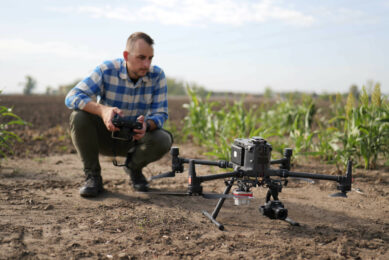‘A short guide on buying a drone’

Along with autonomous robots, spraying drones is the hottest topic in precision agriculture today. And even though it’s a relatively new domain, the farmers have already a wide range of models and producers to choose from. But what should you take in consideration when buying a drone for spraying?
I must point out from the very beginning that in most cascades these drones can be used also for scouting fields using different sensors or for spreading solid granular substances, such as fertilizers or seeds. But we will focus on spraying which is the main purpose for which you will use such a tool.
You must have this in mind – spraying drones is a tool and is meant for applying crop protection substances on your crops, so, you should focus your search on things which make it better for this job. Don’t focus on side options like number of cameras, flashy app or joysticks and other such gimmicks.
1. Nozzles – as I’ve said, the primary job is to apply crop protection products on your crops. And nozzles are one if not the most important part in doing so. Keep in mind that still a lot of drones are coming equipped with nozzles similar or identical with the ones found in traditional spraying machines. And even if this might be seen as a benefit, it is not. Because when spraying with drones, the mix of crop protection (CP) products with water have a different ratio – way less water is used, or that so-called ultra low volume. This means that the mix is usually more viscous or has a bigger share of solid particles in water. As a result the nozzles can be clogged frequently or they can apply a different amount of substance per hectare than desired.
2. Pump – following the logic from above – you want to be sure that your drone is equipped with a pump (or more) which can handle such viscous substances. It is more important this aspect than having a pump capable of delivering a high volume of mix in a short time, as with drones you will apply low volumes of mix.
Text continues below picture

3. Batteries and chargers – how many minutes a drone can fly with a fully charged battery it is important. But do you know what is even more important? How fast you can charge back that battery. So pay a lot of attention to this factor when doing your homework before making a decision. Size of the electric generator is also important here, as you don’t want to use a big trailer behind your pickup truck for carrying the drone, generator and other accessories.
Choose a dealer
Beside these three very important factors from above, choose also the dealer with the best and fastest service in your area, because the drone spraying is not meant to replace mounted, trailed and self propelled sprayers – should be seen as an ambulance for your crops. When the conditions are not right for traditional sprayers you take the drone and do the job.
In the end pay a big attention to your local legislation in operating drones and in applying crop protection products with drones. In most of the world countries this is not well or at all regulated and you might be in trouble.
Text continues below picture

Join 17,000+ subscribers
Subscribe to our newsletter to stay updated about all the need-to-know content in the agricultural sector, two times a week.



